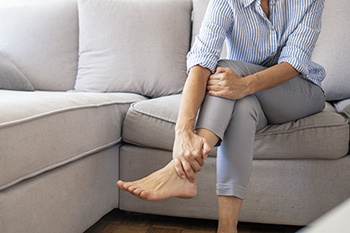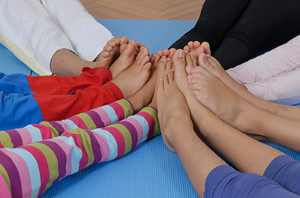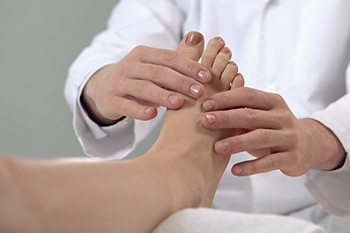Items filtered by date: September 2022
Possible Causes of Toe Pain

Toe pain can range from mildly irritating to severely debilitating. Some possible causes of toe pain include arthritis, bunions, injuries, and more serious conditions like peripheral artery disease. The toes contain 14 bones plus joints, muscles, tendons, ligaments, nerves, and blood vessels. All of these can be injured, infected, or subject to other conditions that cause pain. Beyond pain, symptoms one can experience in their toe region are swelling, redness, numbness, and warmth. If you are experiencing toe pain but cannot determine the cause, or the pain is getting worse, seek the counsel of a chiropodist who can diagnose the problem and provide appropriate treatment options.
Toe pain is common and can have a variety of causes. Causes can range from a broken toe to an ingrown toenail. Many types of toe pain can be corrected, but any toe pain that inhibits your activities for an extended period should be discussed with a chiropodist. If you suffer from toe pain, please consult with one of the chiropodists from Complete Family Footcare & Therapy. Our clinicians can help you maintain the health of your feet.
Common Causes of Toe Pain
- Trauma or fracture
- Cuts, sores, or bruises
- Rheumatoid arthritis
- Gout
- Turf Toe
- Morton’s neuroma
- Blisters
- Corns
- Bunions
- Hammertoes
- Ingrown toenails
- Plantar warts
- Athlete’s Foot
Symptoms of Toe Pain
- Toe deformity
- Burning
- Numbness
- Toenail deformity
- Wart or ulcer
- Swelling
- Redness
When to See a Chiropodist
- Bleeding or severe swelling
- Trauma, such as a broken bone
- Discoloration or extreme swelling
- Inability to bear weight
- Persistent pain
- Wounds that won’t heal
Diagnosis of Toe Pain
A chiropodist can conduct a thorough examination of the painful toe or toes in order to determine the best course of treatment. The exam may include assessing the tenderness of the area, taking an X-ray or other diagnostic test, or assessing your gait and range of motion. A discussion of what led to the advanced pain issue may follow. Included will likely be a health history, as well as a list of medications you are taking and other previous injuries you may have sustained.
Treatment for Toe Pain
With such a wide range of possible causes for toe pain, treatment can be varied in scope and length. Sometimes, the chiropodist will recommend lifestyle and activity changes. In cases of trauma or other injuries, X-rays or imaging tests will likely be used to determine the severity of the problem, particularly if any bones have been broken. Treatment may also include injections of pain-relief medication or anti-inflammatory drugs. Certain injuries will require the splinting, bracing, or wrapping of injured toes. Orthotics or special shoes may be prescribed in cases of bone deformities and gait issues. Removal of warts, calluses, and corns may be needed. In other cases, such as with patients who have diabetes or rheumatoid arthritis, ongoing treatment may be required to avoid more serious problems.
When Joint Pain in the Feet Is Rheumatoid Arthritis

Rheumatoid arthritis (RA) is a condition where the immune system attacks the joint lining tissue, causing painful inflammation and stiffness. Many people suffering from rheumatoid arthritis develop symptoms of this condition in their feet. This usually presents as pain or stiffness in the toe joints and ligaments throughout the foot. Additional symptoms include persistent aching of the feet, abnormal warmth in one or more parts of the foot, and swelling in toe joints or ankles. Lumps or nodules can form on the heel, Achilles tendon, or ball of the foot. If left untreated, claw toes or hammertoes can develop. Over time, mobility in the feet can be affected. There can also be long term joint destruction. This happens when bone, cartilage, and other joint tissue breaks down and can make the foot joints weaker and extremely painful to use. A change in the shape of the foot might also be noticed. With this disease, there are often flareups followed by periods where symptoms are absent or less noticeable. Aging may exacerbate this condition. Given how debilitating RA can become, it is important to include a chiropodist among the health care professionals you regularly visit.
Rheumatoid arthritis (RA) is an autoimmune disorder in which the body’s immune system attacks its own otherwise healthy joint lining or synovium. While RA can affect any joint in the body, it often affects the small joints of the feet and the ankle joint. If you’re dealing with RA in your lower limbs, please consult with one of the chiropodists from Complete Family Footcare & Therapy. Our clinicians can help you maintain the health of your lower limbs and your mobility.
Symptoms of RA primarily affect the joints of the feet and may include:
-
Pain
-
Swelling
-
Stiffness
-
Redness
-
Warmth
-
Difficulty walking
-
Gait changes
-
Bunions
-
Hammertoes
Treatment
While there is no cure for RA, your chiropodist can help you manage the health of your feet and maintain your mobility while living with this condition. Possible treatments include wearing orthotics, doing foot and ankle exercises, resting the feet, taking anti-inflammatory medications, getting steroid injections, and wearing braces for foot and ankle pain. In advanced cases of RA, joint replacement surgery may be helpful for mobility. Bunions, hammertoes, and other deformities can be corrected with surgery as well.
If you have RA, please feel free to contact our offices located in . We offer the newest diagnostic and treatment technologies for all your foot care needs.
Juvenile Osteochondritis Dissecans

Juvenile osteochondritis dissecans (JOCD) is a disorder that occurs in young people whose growth plates have not closed yet. A joint is where two bones come together. Normally hard bone is covered with a softer form of bone called cartilage at the joint surface. With JOCD, a piece of bone and the cartilage that covers it becomes loose and at times float around inside the joint. The ankle is one such joint where this can occur. It is more common in active children and young adolescents. JOCD is thought to be related to repetitive trauma to the affected area. Those who have this condition usually feel a vague pain that gets worse with activity and improves with rest. There may be a feeling of the joint locking or getting stuck. Sometimes the joint affected may become swollen. Initially, one who has this will want to immobilize the foot and modify activity. Surgical treatment might be necessary. Most kids recover well from this condition, but it can lead to early arthritis. If you feel your child is suffering from this disorder or has any other foot or ankle pain, see a chiropodist who can diagnose and treat such conditions.
If your child is experiencing foot or ankle pain, please consult with one of the chiropodists from Complete Family Footcare & Therapy. Our clinicians will assess your condition and provide you with quality foot and ankle treatment.
Common Causes of Foot Pain in Children
While children can experience many of the same foot problems as adults do, some foot problems may be more common during childhood.
Causes of foot pain in children can include:
-
Deformities that are present from birth, such as flat feet or clubfoot
-
Sever’s disease, which is an inflammation of the growth plate in the heel bone
-
Various sports injuries, such as sprains and fractures
-
Ingrown toenails
-
Athlete’s foot
-
Plantar warts
Prevention
It is important to look after the health of children’s feet in order to prevent future problems from arising. Keep your child’s feet clean and dry, trim their toenails regularly, ensure their shoes fit properly, and keep a watchful eye on any symptoms of foot pain, such as limping. If you notice any symptoms or if your child complains of foot pain, a chiropodist can help.
If you have any questions, please feel free to contact our offices located in . We offer the newest diagnostic and treatment technologies for all your foot care needs.
Examining the Differences Between Walking and Running Shoes

You might not think there are any differences between walking shoes and running shoes, but there are. These differences can have an effect on the quality of your workouts and the health of your feet. A good walking shoe will feature comfort and flexibility. The heel should not be flared, but rather undercut to allow a heel-to-toe rolling motion involved in the walking gait. Walking shoes offer arch support and must have more flexibility and be able to bend more than a running shoe. Running shoes are lighter and built for speed, with more cushioning needed in the forefoot and a flared, built-up heel to provide the runner’s foot stability. Before you buy new walking or running shoes, you would be wise to have your feet and gait analyzed by a chiropodist who can suggest specific features for your individual needs, foot structure, gait, or running stride.
Finding the right shoes can sometimes be a major hassle, especially if you intend to work out in them. There are shoes on the market designed specifically for running and walking, but it can be difficult to differentiate between the two and find the right shoes for you. If you’re having trouble finding the right shoes, please consult with one of the chiropodists from Complete Family Footcare & Therapy. Our clinicians can help you maintain the health of your lower limbs and your mobility.
What are the differences between running and walking shoes?
These two types of shoes vary along several parameters.
-
Cushioning: Runners need more cushioning in the heel and forefoot areas of the shoe, while walkers can get away with less cushioning.
-
Heel height: Runners need a higher heel to provide them with stability, but the ideal height of the heel for runners varies depending on their running gait. Walkers generally don’t need a built-up heel.
-
Heel flare: Flared heels can help provide extra stability for runners with certain gaits, while walkers may benefit from a flared heel to control the motion of their foot.
-
Flexibility: Both runners and walkers need shoes that are flexible.
For more information about the differences between walking and running shoes, and to figure out which shoes may be right for you, please consult with a chiropodist. Feel free to contact our offices located in . We offer the newest diagnostic and treatment technologies for all your foot care needs.

